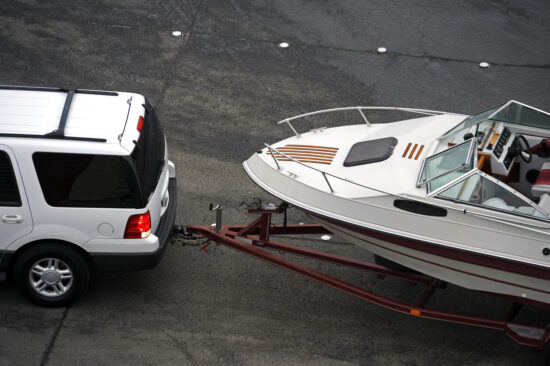A boat trailer isn’t nearly as fun to shop for as the actual boat. We completely understand.
Be that the case, you’ll need a reliable boat trailer to haul your boat (and, in some cases, to store your boat). If you don’t have a way to haul your boat or transport it, you may find yourself in a tough position.
There are several types of boat trailers to choose from, and our guide on the types of boat trailers will help you narrow down this information and decide which trailer features you need.
Key Takeaways
When choosing a boat trailer, you’ll need to account for the following factors:
- The type and size of your boat
- Cost
- Type of vehicle towing the trailer
- Duration of weight load
- Type of trailer suspension
- Type of frame material
- What boat trailer accessories are necessary
Common Types of Boat Trailers

There are four different types of boat trailers to choose from when it comes to hauling and storing a boat properly and securely:
- Bunk trailers
- Roller trailers
- Float-on trailers
- Keel rollers
Bunk Trailers
Commonly seen hauling smaller boats, generally less than six meters in length, bunk trailers are fairly simple in design (typically single axle trailers), making them ideal for various boat towing needs. Their smaller size makes them much more affordable than the average roller trailer.
Bunk trailers support the boat’s keel with boards, also known as “trailer bunks”, that run down the sides of the trailer. Typically, the “bunks” are protected by soft, felt-like fabric that makes it easier to slide the boat off of the trailer and place it directly into the water. The felt also helps prevent scratches in the hull of the boat.
Pros
- Simple to use and have few working parts
- Minor maintenance required
- More affordable than other boat trailers
Cons
- Must be submerged in deeper water to load and unload the boat (could lead to corrosion)
- Getting the boat off the trailer can be challenging on shallow ramps or at low tides
Roller Trailers
Roller trailers support the boat’s weight with multiple cylindrical pieces of plastic, which helps “roll” the boat into the water as you back down the ramp. Roller trailers, which don’t have to be submerged as deeply as bunk trailers, are ideal for putting your boat in the water at a shallow ramp or at low tide.
Usually, drivers of roller trailers back the boat into the water. Once the back of the boat is floating, you’ll be able to change the alignment of the truck and trailer to get the trailer and boat in the optimal position.
Pros
- Don’t have to be submerged as deeply as other trailers
- Rollers make it more convenient to launch the boat
- Can be used for a larger hull
Cons
- More expensive upfront costs
- Typically need a vehicle with higher tow vehicle capability and gross vehicle weight rating
Float-on Trailers
Float-on trailers are ideal for larger boats that may require deeper water to launch effectively and without damage. They’re ideal if you own a saltwater boat, pontoon boat, and/or other larger boats. They’re also fairly simple to use to load and drop.
To drop a boat into the water off a float-on trailer, simply back the trailer into the water until it’s submerged enough for the boat to float off and detach from the trailer.
To load a boat, float-on trailers are usually backed deep enough into the water that the boat can be floated onto the trailer, usually by using a guiding rope from the ramp or dock.
Pros
- Great choice for larger boats that require a larger trailer size
- Trailer boat parts should not need to be submerged as deeply
- Trailer weight capacity is slightly higher
Cons
- Not a great fit for smaller boats
- Takes more time to master than a standard bunk-style trailer
Keel rollers
Keel rollers, rather than being trailers themselves, are used to help support a boat on a traditional trailer, decreasing the risk of damage to the boat and increasing the ease of loading and unloading.
Keel rollers attach to an existing trailer (bunk trailer or even roller trailer), absorbing the shock of launching or hitching the boat, as it rolls the boat smoothly into place on the trailer.
Generally, they are placed along the centerline of the boat trailer to help support and protect the keel of the boat.
Pros
- Makes it easier for boat owners to launch a boat even on their own
- Boat and trailer parts experience less damage due to the keel rollers
- Good for both saltwater and freshwater boating
Cons
- Not a true boat trailer, more of a trailer accessory
- Can decrease towing capacity with extra weight
How To Choose A Boat Trailer
Picking the right boat trailer for your needs isn’t as simple as snagging a trailer of the same size as your boat. You must also consider legal requirements for hauling, heavy-duty materials, weighting, and more.
Don’t leave yourself unprepared at the boat ramp.
Boat Type and Size
When trying to buy a trailer for your boat, the first thing you need to consider is the size of your boat. Start by classifying the type of boat you want to haul according to boat class (Class A, Class 1, Class 2, Class 3). Using resources like these, you’ll find a rough estimation of your boat’s dimensions.
If you want exact measurements, you’ll want to measure your boat from front to back and from one side to the other. (length and width). Remember that a small boat trailer can’t fit a larger boat. Your boat trailer needs to be at least as long as your boat.
For example, when you purchase a pontoon boat, you’ll need to add 3′ to 5′ in the turning radius to the boat’s length to allow an adequate swing radius in case of tight turns.
Generally, a single-axle trailer can accommodate a boat up to 22 feet, with a maximum weight of around 3,300 pounds. If you have a larger boat, you may need to consider going up to a larger trailer size.
Remember that certain types of boats may have a more prominent influence on the type of trailer you need. For example, pontoon boats can easily launch in shallow water, which means they may function just fine on a roller trailer.
Affordability
When choosing a boat trailer, price may be the deciding factor when it comes to your preferred boat trailer type. To calculate how much you’re willing to pay for a boat trailer, be sure to factor in the cost of maintenance and the initial purchase.
Bunk trailers are often more affordable to purchase and maintain than roller trailers or float-on trailers. Larger trailers, including double-axle trailers, are also frequently more expensive.
Type of Vehicle That Will Tow the Trailer

When considering your boat and trailer purchase, you’ll also need to consider the obvious: the type of vehicle you plan to use to tow your boat and trailer.
Each vehicle has a set towing capacity, otherwise known as the amount it can haul. Sometimes, you can find this information on the sticker inside the door of your vehicle. Other times, you’ll need to calculate it yourself by researching the VIN number.
Keep in mind that towing capacity will need to accommodate the weight of any passengers and cargo, as well as the weight of the boat and its adjoining trailer.
If you look up your vehicle’s towing capacity online, that vehicle’s history may also change towing capacity. Some types of collisions can cause damage to the vehicle that may decrease its overall towing capacity.
Once you know the vehicle’s towing capacity, look at the weight of your boat and your trailer. You will also have to consider your trailer weight carrying capacity. If you’re coming close to the maximum towing capacity of your vehicle or trailer, you may want to consider a different setup.
In general, you should add 15% to the boat and trailer’s weight when calculating overall towing weight for safety and to ensure that your vehicle has the right towing capacity.
According to federal regulations, you can only drive a combined weight of up to 26,000 pounds of truck, trailer, and cargo without a Class C driver’s license.
If the combined weight of your truck, trailer, and boat exceeds that maximum amount, you may need to choose a different towing combination for your boat or consider testing for your Class C license.
Duration of Weight Load
Carefully consider how long your boat will likely be sitting on its trailer. Some people only place their boat on a trailer when it’s headed to the water — or, at most, for a trip in for maintenance or a longer road trip to reach a different body of water.
Other people, however, will store their boats on their trailers during the winter months when boating season is no longer in session.
Galvanized steel trailers tend to be some of the more durable long-term options.
Other Boat Trailer Accessories
When it comes to selecting the right boat trailer, the boat trailer hubs, suspension systems, and even corrosion resistance are all key factors. When investing in a comprehensive boat package, pay attention to the accessories included, as well.
Wheels/Tires
Trailer tires are built to carry heavy loads. Look at tread patterns and assess wear in trailers that are not brand new to ensure your .
Lights
Trailer lights on the tail of the trailer will hook into your vehicle system; LED lights can last longer and increase overall brightness on the road; having additional trailer lights to improve visibility is quite helpful
Jacks
For smaller boats, the single-wheel jack is common; larger boats need a dual-wheel jack or a foot jack to support the weight of the boat. Also, take a look at the winch and how it operates; clearly, a winch to pull a kayak or aluminum boat will be much different than a large cruiser.
Rollers/Guides
Rollers and guides are ideal for new boat owners and those who are planning to load in windy conditions or heavy currents. Most trailer packages come with some type of roller or guide.
To ensure you’re comfortable with your selection, look at both spring suspension and the more modern torsion axles; these, along with the rollers/guides will play into your overall experience towing your trailer.
Steps/Ladders
Is climbing into the trailer something you can do with ease? Manufacturers offer trailer packages with both steps and ladder solutions.
Break-away Components
If your trailer is in an accident, you need to understand what will happen to the vehicle, the boat, and the trailer. Breakaway components help the trailer release from the vehicle. Take specific note of the tie-downs and straps used, as they will also play into this.
Your Boat Trailer is Also a Serious Investment
Choosing the right boat trailer is a big decision, whether you’re purchasing a boat and trailer together or separately. With these strategies, however, you can ensure you have the information you need to choose the ideal trailer.
Once you have a trailer, you’ll need to decide where you’re planning on hauling the boat, post-lake-day (or post-boating season). Look at some of the boat storage options that Neighbor has. Peer-to-peer storage can help cut down costs and give you that added convenience you may not get at a traditional storage facility.







